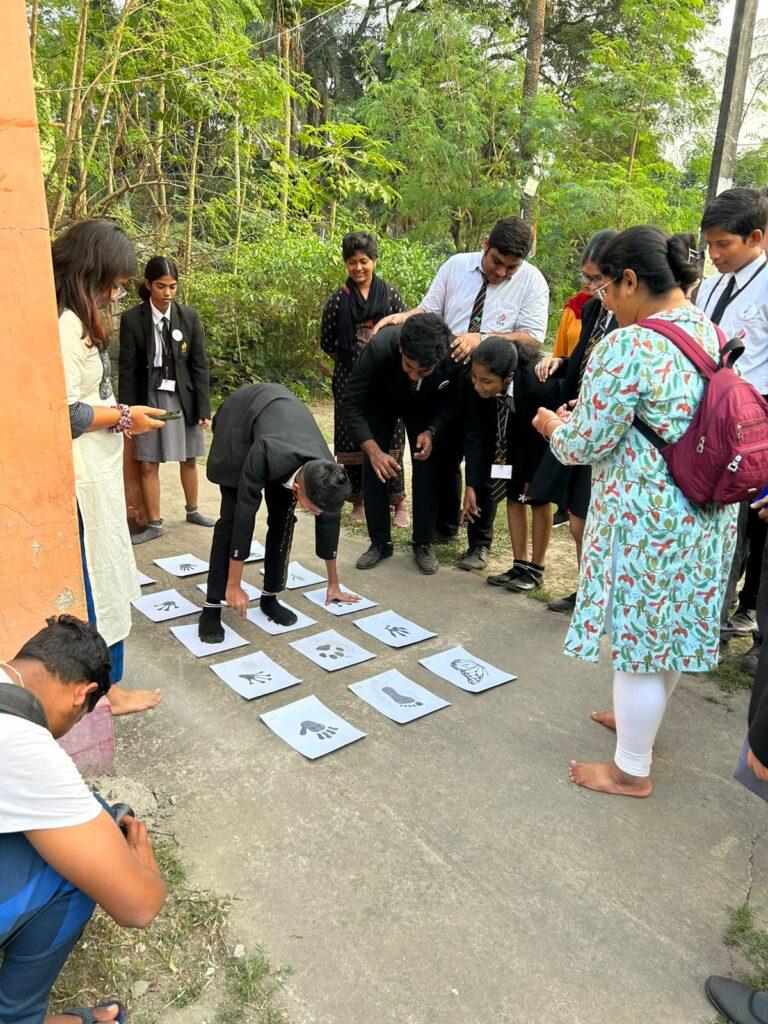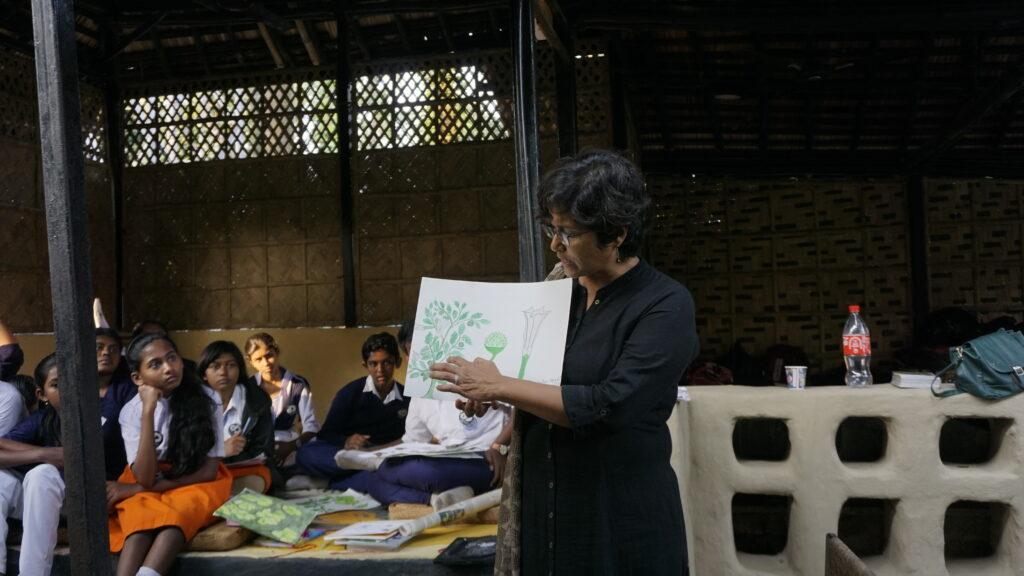Meet an Educator is a monthly series by Early Bird, where we feature the work of educators across India who are actively spreading the joy of birds and nature. This month’s featured educator is Nobina Gupta, a social arts practitioner working in Kolkata, and Curator-Director of Disappearing Dialogues (dD). As a nature educator, she focuses on process, practice, and everyday life, and uses art as a catalyst to address critical ecological issues and drive change.
Do tell us about yourself, where you are from, and your work
As an alumnus of Kala Bhavan, Santiniketan, I am a social arts practitioner dedicated to working within communities and spaces rich in ecological, social, and cultural traditions that are currently at risk of disappearing. My work focuses on conceptualising alternative modes of engagement and conservation, using art as a catalyst to address critical ecological issues and drive change. Born and raised in Jabalpur, Madhya Pradesh, I have been inspired by nature and creativity since childhood, which has guided me towards holistic research and artistic endeavours, including extensive travels to interior regions.
What excites you about the natural world?
The unbound creativity of nature, with its constant rejuvenation, always inspires and surprises me. Both the micro and macro elements of nature drive me to examine, explore, and learn daily from the unknown world we inhabit. The multitude of species, each with their artistic characteristics and unique behavioural patterns, and the monumental vastness of landscapes remind me of our miniature presence within this natural world.

The unpredictable forces of nature acting rapidly beneath the surface are a constant reminder of our connection to this dynamic environment. These mesmerising discoveries and experiences shape my philosophy of living, bringing hope and contentment amidst the despair and distress of contemporary life.
When and how did you get interested in bird/nature education?
As an environmental social arts practitioner, my interest in bird and nature education developed over years of research and travel across diverse landscapes. These experiences provided me with the impetus and inspiration for creativity, knowledge-building, and sharing. Nature, with its vast teachings, and the communities that serve as custodians of ecological spaces and traditional knowledge systems, have been pivotal in this journey.
Observing the increasing vulnerability of these eco-spaces and traditional practices highlighted the urgency of conservation and education. I believe it is crucial for everyone, especially the younger generation, to understand and appreciate these invaluable resources, as they will be the leaders of tomorrow. This realisation motivated me to focus on nature education as a means to foster awareness, stewardship, and sustainable practices.

What do you hope to achieve through your education work?
As a nature educator, I aim to focus on process, practice, and everyday life. In my role as the Curator-Director of Disappearing Dialogues (dD), I have worked to amplify the voices of the East Kolkata Wetlands community, advocating for its traditional practices on various national and international platforms. Our mission involves archiving the wetland ecosystem and addressing its socio-spatial realities to catalyse environmental conservation.
By developing young wetland ambassadors through creative methodologies, we empower and enrich communities to work collaboratively towards sustainability and climate resilience. My goal is to find alternative solutions that value and enhance existing assets, ensuring long-term, grounded conservation.

Why do you believe it is important for children to learn about birds or connect with nature?
It is crucial for children to learn about birds and connect with nature because this knowledge fosters empathy and respect for the non-human world, helping them understand that we share an interconnected ecosystem. Experiential learning allows children to see firsthand the symbiotic relationships that sustain our environment. Without these experiences, children may struggle to connect their education and skills to their surroundings, impeding their ability to contribute to a sustainable future.
Moreover, engaging with nature enhances children’s emotional well-being and supports holistic learning. Activities in natural settings provide a dynamic and immersive educational experience, encouraging curiosity, creativity, and critical thinking. The wonders of nature and the open sky offer unique opportunities for hands-on learning, promoting a deeper understanding of ecological systems and the importance of conservation. By instilling these values early on, we prepare children to become informed and responsible stewards of the environment, ensuring a healthier planet for future generations.

What tools or resources have helped you in teaching about birds? Can you describe an approach that has worked exceptionally well for you?
Art as the main tool for engagement has been designed as a sequence of collaborative, participatory processes. The engagement explores notions of environment and everyday practices, the importance of collective engagement and addresses local school curriculum to connect with their surroundings as well. These pedagogical processes are structured to build on existing and emergent community local knowledge, cultural practices, natural history and heritage and natural resources. Through collaborative art, performance, installations, workshops, exhibitions and DIY activities, nature education has been able to co-create possibilities.
Our research-based workshops within East Kolkata Wetlands (EKW) involve travelling around the wetlands and along the wastewater canals – collecting samples, recording data and observations through drawings and writings. Early Bird’s educational tools have helped us guide the children to understand and value the ecological wealth of the EKW and give them a sense of pride. The collection of personal observations, samples and findings have been compiled into a nature journal and an illustrated co-created journal with the children is in process.


We have also collaborated with Wipro Earthian for the Sustainability Education Program for schools with the aim of unleashing the inherent talents of young learners, challenging their backgrounds and enabling them to think and express about present issues in a critical, free and reflective manner. Our process of collective art making, and pictorial storytelling was a tool of dialogue to share experiential and often, subliminal learning.
We are trying to create opportunities for the young learners to explore and reinvent themselves and build new conservation initiatives by presenting their collaborative works and creative ideas in exhibitions, through installations, live performances, visits and workshops in art galleries and interactions with experts.
Have you encountered a significant challenge as a bird/nature educator, how did you overcome it?
As a bird and nature educator, one significant challenge I encountered was engaging students who initially lacked interest in environmental topics. To overcome this, I adopted a multifaceted approach and creativity to make learning more engaging and relevant.
Firstly, I incorporated experiential learning by curating and facilitating wetland discovery trails with hands-on activities that allowed young learners to interact directly with nature and not from books or net. By observing birds in their natural habitats, experiencing the seasonal changes along with participating in creative ecology projects, they could connect theory with real-world experiences.

Secondly, I integrated art into environmental education. Art projects within our nature explorer labs helped students express their observations creatively, through journaling, paintings, murals, storyboards, illustrations, pop-up exhibitions, designing engagement tools making the learning process enjoyable and memorable, facilitating a deeper emotional connection.
Additionally, using multimedia tools such as videos on specific topics, interactive apps – eBird, Merlin, iNaturalist, and interactive posters by Early Bird helped bring distant ecosystems and bird species into the classroom, sparking curiosity and enthusiasm among students.

Moreover, encouraging interdisciplinary learning, linking bird and nature education to other subjects like geography, history, and literature helped students see the broader relevance of environmental topics and understand their interconnectedness with various aspects of life. By fostering an environment that valued curiosity and inquiry, students became active participants. This not only increased their engagement but also nurtured a sense of responsibility towards the environment.
Through these strategies, I was able to transform students’ attitudes towards alternative education, fostering a passionate, inquisitive, and environmentally conscious group of learners.
Do share any memorable moment or experience you have had in teaching kids about birds/nature. Can you recall any insightful instance that shaped your perspective?
I have dedicated my career to working with children across diverse regions, from the Changthang valley in Leh-Ladakh to Bundelkhand and Baghelkhand in central India, and now within the East Kolkata Wetlands, along with city school students.
Through this journey, I have found that children in these communities possess immense traditional and ecological knowledge, yet remain unaware of the value of this knowledge. Their everyday practices and lived experiences offer more information than any book or research paper could provide.

My perspective on knowledge and nature education has been profoundly shaped by my interactions with these children. It saddens me to see that they often feel incapable and inferior compared to city school children. Currently, we are engaging with a group of children from the East Kolkata Wetlands to build living archives within their communities.
Our goal is to empower them and enhance their skills, fostering a sense of confidence in their grounded experiences and knowledge. We hope this will create a chain reaction, enabling these children to communicate their strengths and abilities effectively in the near future.
Have you noticed any changes in your learners after they received exposure to birds and nature-based learning? If yes, what are they? If not, why do you think that is?
Yes, I have noticed significant changes in my learners after they were exposed to nature-based learning and activities. The younger generation is naturally sensitive to environmental impacts but often lacks an understanding of the interconnections within their surroundings. Traditional school curricula cover topics such as nature, environmental diversity, climate change, sustainability, and conservation, yet these lessons are frequently confined to textbooks without real-world examples or hands-on experiences.
The community students who have grounded knowledge don’t know that it is so valuable and important. Our education system doesn’t acknowledge traditional knowledge and practice as a source of information and insight.


Through our Nature Explorer Labs and Wetland Discovery Walks, students engage directly with their environment by observing and learning about various species, habitats, ecological patterns, processes, microorganisms, and natural resources. This experiential learning approach helps them grasp the complexities and interdependencies of nature more effectively and reflect on the current environmental challenges.
As a result, students become more proactive and conscious about their behaviours and attitudes towards the environment. They start to appreciate the importance of sustainability and conservation and are inspired to become change-makers in their own communities. By fostering a sense of responsibility and connection to the natural world, nature-based education equips young learners with the knowledge and motivation to contribute to a healthier, more sustainable future.
What message would you have for your fellow educators, or somebody starting out in their nature education journey?
Nature education should be holistically defined and applied, incorporating multiple perspectives and methodologies. There’s no one-size-fits-all approach; the more localised the content, the better learners can relate to, understand, and apply it effectively. Utilise unconventional pedagogical tools and exploratory methods to make learning more engaging, enjoyable, and meaningful.


Embarking on a nature education journey requires passion, patience, and perseverance. Both students and educators benefit from the continuous learning process it entails. While formal training can be valuable, what truly makes a great educator is a genuine love for learning and teaching. Encourage curiosity and foster a deep connection with the natural world in your students, and remember that your enthusiasm can inspire a lifelong commitment to environmental stewardship.

